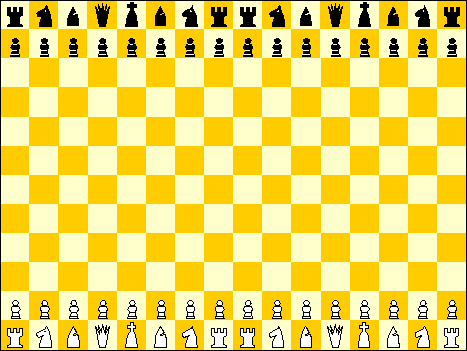Double Chess
This really large variant was invented in 1916 by Julian S. Grant Hayward, and have been published (amongst others) in 1929 in the British Chess Magazine. Capablanca has played this game in 1929 in a match with 4 games against Hungarian chess master Geza Maroczy. (Capablanca won two games, the others were drawn.)
Rules
The game is played by two players on a board of 16 by 12 squares. Each player has two sets of chess-pieces, i.e., two kings, two queens, four rooks, four bishops, four knights, and sixteen pawns. The opening setup is obtained by using the ordinary setup, and repeating it, so, e.g., white has kings on e1 and m1, and black has kings on e12 and m12, and all pawns are on the second and 11th row in this opening setup.
 White:
White:
King e1, m1; Queen d1, l1; Rook a1, h1, i1, p1; Knight b1, g1, j1, o1;
Bishop c1, f1, k1, n1; Pawn a2, b2, c2, d2, e2, f2, g2, h2, i2, j2, k2,
l2, m2, n2, o2, p2.
Black:
King e12, m12; Queen d12, l12; Rook a12, h12, i12, p12; Knight b12, g12,
j12, o12; Bishop c12, f12, k12, n12; Pawn a11, b11, c11, d11, e11, f11,
g11, h11, i11, j11, k11, l11, m11, n11, o11, p11.
Each king can castle with the two rooks that `belong to its own half of the board', so the white king on e1 can castle with the rook on a1 or on h1, under the normal restrictions of usual chess.
Each pawn may on its first move either move one, two, tree, or four squares. Once a pawn has moved, it can only move one square. A pawn can be taken en-passant on each of the squares it passes over. Pawns promote as usual on the last row of the board.
When a player mates one of the kings of the opponent, he wins the game.
Written by: Hans Bodlaender.
WWW page created: 1995 or 1996.